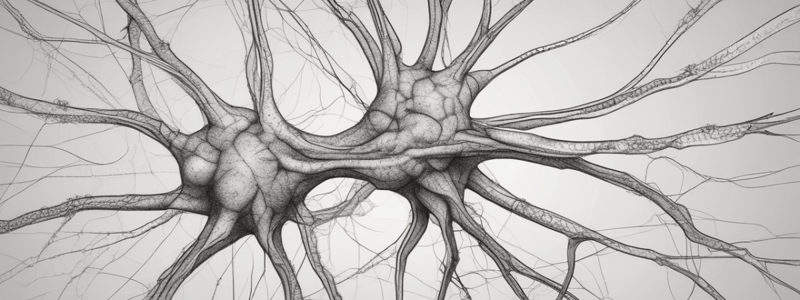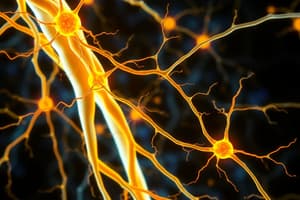Podcast
Questions and Answers
Where is the cell body of a motor neuron typically located?
Where is the cell body of a motor neuron typically located?
- Muscle fibers
- Neuromuscular junction
- Peripheral nerves
- Spinal cord and brain stem (CNS) (correct)
What is unique about the relationship between a motor neuron and muscle fibers?
What is unique about the relationship between a motor neuron and muscle fibers?
- Each motor neuron can only attach to one type of muscle fiber
- Each muscle fiber can only have one motor neuron attached (correct)
- Each motor neuron is attached to only one muscle fiber
- Each muscle fiber is attached to multiple motor neurons
What is the term for the group of muscle fibers stimulated by a single motor neuron?
What is the term for the group of muscle fibers stimulated by a single motor neuron?
- Synaptic complex
- Muscle fiber bundle
- Neuromuscular junction
- Motor unit (correct)
What is the direction of electrical impulses across the neuromuscular junction?
What is the direction of electrical impulses across the neuromuscular junction?
What is the pre-synaptic side of the neuromuscular junction also referred to as?
What is the pre-synaptic side of the neuromuscular junction also referred to as?
What is the function of the synaptic cleft in the neuromuscular junction?
What is the function of the synaptic cleft in the neuromuscular junction?
After the influx of calcium into the presynaptic terminal (due to the opening of the voltage gated calcium channels), what immediately happens next?
After the influx of calcium into the presynaptic terminal (due to the opening of the voltage gated calcium channels), what immediately happens next?
What happens to small amounts of acetylcholine in the synaptic cleft?
What happens to small amounts of acetylcholine in the synaptic cleft?
What is the result of organophosphate toxicosis on acetylcholinesterase?
What is the result of organophosphate toxicosis on acetylcholinesterase?
What is the effect of irreversible inactivation of acetylcholinesterase?
What is the effect of irreversible inactivation of acetylcholinesterase?
What is the purpose of acetylcholinesterase in the synaptic cleft?
What is the purpose of acetylcholinesterase in the synaptic cleft?
What is the result of prolonged overstimulation of nicotinic receptors within chronic cases of Organophosphate Toxicosis?
What is the result of prolonged overstimulation of nicotinic receptors within chronic cases of Organophosphate Toxicosis?
What is the effect of botulinum toxin on SNARE proteins?
What is the effect of botulinum toxin on SNARE proteins?
Which of the following has these 7 toxin types: A, B, C, D, E, F, G?
Which of the following has these 7 toxin types: A, B, C, D, E, F, G?
What is the primary cause of animal poisoning?
What is the primary cause of animal poisoning?
How can botulism be contracted?
How can botulism be contracted?
What is the result of overstimulation of the central receptors in Organophosphate Toxicosis?
What is the result of overstimulation of the central receptors in Organophosphate Toxicosis?
What is the primary symptom of botulism?
What is the primary symptom of botulism?
What is the result of overstimulation of the muscarinic receptors in Organophosphate Toxicosis?
What is the result of overstimulation of the muscarinic receptors in Organophosphate Toxicosis?
What is the underlying cause of Myasthenia Gravis?
What is the underlying cause of Myasthenia Gravis?
Which type of Myasthenia Gravis is present from birth?
Which type of Myasthenia Gravis is present from birth?
What is the typical age at which symptoms of congenital Myasthenia Gravis become apparent?
What is the typical age at which symptoms of congenital Myasthenia Gravis become apparent?
What is the difference between Carbamate toxicosis and Organophosphate Toxicosis?
What is the difference between Carbamate toxicosis and Organophosphate Toxicosis?
When is the anti-toxin most effective in treating botulism?
When is the anti-toxin most effective in treating botulism?
Where are the acetylcholine receptors located in the postsynaptic membrane?
Where are the acetylcholine receptors located in the postsynaptic membrane?
What is the purpose of the subneural clefts in the synaptic cleft?
What is the purpose of the subneural clefts in the synaptic cleft?
What is the result of giving anti-toxin to a patient after the botulism toxin has already been activated?
What is the result of giving anti-toxin to a patient after the botulism toxin has already been activated?
What is the primary function of mitochondria in the pre-synaptic terminal?
What is the primary function of mitochondria in the pre-synaptic terminal?
Which of the following causes exercise -induced weakness?
Which of the following causes exercise -induced weakness?
Which species are fairly resistant to all types of botulism toxins?
Which species are fairly resistant to all types of botulism toxins?
Which of the following statements is correct?
Which of the following statements is correct?
What is the function of the active zone in the presynaptic terminal?
What is the function of the active zone in the presynaptic terminal?
How many motor endplates can a muscle fiber have?
How many motor endplates can a muscle fiber have?
What is the maximum number of motor units that a motor neuron axon terminal can have?
What is the maximum number of motor units that a motor neuron axon terminal can have?
Which of the following is an autoimmune disorder where IgG is against the acetylcholine receptors?
Which of the following is an autoimmune disorder where IgG is against the acetylcholine receptors?
What is an extraocular muscle an example of?
What is an extraocular muscle an example of?
Flashcards are hidden until you start studying
Study Notes
Motor Neurons
- Located in the CNS (spinal cord and brain stem)
- Axon travels through peripheral nerves and synapses with effector organs (muscle fibers)
- Each muscle fiber can only have one motor neuron attached
- Each motor neuron can be attached to multiple muscle fibers
- Demonstrates an "all or nothing" response associated with motor units
Neuromuscular Junction (NMJ)
- Specialized synapse between a motor neuron and a muscle fiber
- Each muscle fiber can only have one neuromuscular junction
- Electrical impulses (action potentials) only travel unidirectionally across the NMJ
- Composed of:
- Pre-synaptic side (AKA pre-synaptic terminal)
- Post-synaptic side/membrane (AKA terminal plate)
- Synaptic cleft
Pre-synaptic Terminal
- Terminal portion of the motor neuron with a button-like shape (synaptic button)
- Contains enzyme acetylcholinesterase that destroys acetylcholine by breaking it down into acetyl acid and choline
- Choline is recycled and transported back to the pre-synaptic terminal
Organophosphate Toxicosis
- Caused by insecticide, pesticide, and antiparasitic exposure at a toxic level
- Irreversible inactivation of acetylcholinesterase, leading to excess acetylcholine and overstimulation of acetylcholine receptors
- Symptoms:
- Muscle spasm and twitching (fasciculations)
- Dyspnea (bronchoconstriction and increased bronchial secretions)
- Diarrhea, vomiting, frequent urination, hypersalivation, colic, miosis
- Nervousness, ataxia, seizures, hyperreactivity
- Prolonged overstimulation can lead to desensitization of receptors and flaccid paralysis
Botulism
- Caused by ingestion of Botulinum Toxin (neurotoxin) produced by Clostridium botulinum
- Targets and destroys SNARE proteins via cleavage, preventing acetylcholine release
- Common in birds and chickens, but can occur in fish, horses, cattle, dogs, and cats
- Symptoms:
- Progressive motor paralysis
- Vomiting/regurgitation, dilated pupils, inability to blink, difficulty chewing or swallowing
- Atonic bladder, constipation/reduced peristalsis
- Anti-toxin treatment available if given shortly after ingestion of contaminated food
Myasthenia Gravis
- Abnormal reduction of acetylcholine receptors on the neuromuscular endplate
- Causes exercise-induced weakness
- Can be congenital or acquired
- Congenital form:
- Present from birth
- Recurrent and progressive muscle fatigue apparent at 6-9 weeks of age
Studying That Suits You
Use AI to generate personalized quizzes and flashcards to suit your learning preferences.




